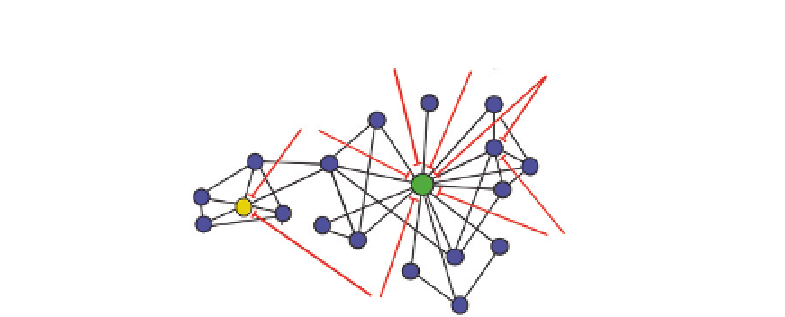Biology Reference
In-Depth Information
miR-A
miR-B
miR-Ca
miR-E
miR-Cb
miR-D
Figure 9.2
MicroRNAs regulate network hubs. Two highly connected nodes are
highlighted in green and yellow, and these have hub-like features. Various miRNAs
preferentially regulate the network through these hubs.
In such networks, target hubs exist that are linked by 15 or more
miRNAs. Strikingly, these target hubs are enriched for TFs (
Martinez
et al
., 2008
) and factors involved in regulation of development (
Shalgi
et al
., 2007
). Target hubs also tend to be more connected by protein-
protein interaction links than lowly connected targets. A positive correla-
tion has been seen between the number of miRNA-binding sites in the
3
0
UTR of a gene and the connectivity of its protein product to other
proteins (
Liang and Li, 2007
). This propensity is not a side result of longer
or evolutionarily conserved 3
0
UTRs (
Liang and Li, 2007
;
Shalgi
et al
.,
2007
). In the case of
C. elegans
, experimental evidence indicates such hubs
are important for miRNA function. Combined knockout of individual
miRNA genes and TF hubs led to synthetic phenotypes that were
otherwise undetectable when either miRNA or hub was knocked out
alone (
Brenner
et al
., 2010
).
Target hubs can be more connected in other ways as well. miRNAs
were found to preferentially target genes encoding enzymes that are meta-
bolic hubs or cut point enzymes (
Tibiche and Wang, 2008
). These are
capable of regulating metabolic mass flow at global and local scales, respec-
tively (
Tibiche and Wang, 2008
). Highly connected scaffold proteins in
signaling networks are also preferentially linked to miRNAs (
Cui
et al
.,
2007
). Scaffold proteins are important components of signaling pathways
that lack enzyme activity but physically interact with upstream and down-
stream components of the pathways, often simultaneously. It has been found
that miRNAs more frequently target highly connected scaffold proteins
than less connected nodes of the same pathways (
Cui
et al
., 2007
). Alto-
gether these results suggest that miRNAs preferentially regulate highly
connected nodes in various types of networks.

